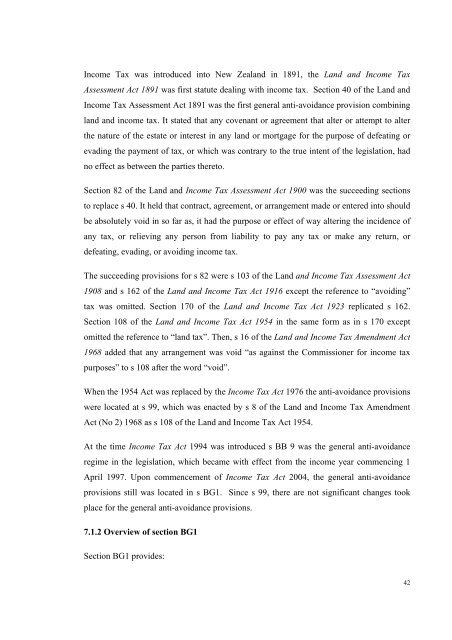Tax Avoidance: Causes and Solutions - Scholarly Commons Home
Tax Avoidance: Causes and Solutions - Scholarly Commons Home
Tax Avoidance: Causes and Solutions - Scholarly Commons Home
You also want an ePaper? Increase the reach of your titles
YUMPU automatically turns print PDFs into web optimized ePapers that Google loves.
Income <strong>Tax</strong> was introduced into New Zeal<strong>and</strong> in 1891, the L<strong>and</strong> <strong>and</strong> Income <strong>Tax</strong><br />
Assessment Act 1891 was first statute dealing with income tax. Section 40 of the L<strong>and</strong> <strong>and</strong><br />
Income <strong>Tax</strong> Assessment Act 1891 was the first general anti-avoidance provision combining<br />
l<strong>and</strong> <strong>and</strong> income tax. It stated that any covenant or agreement that alter or attempt to alter<br />
the nature of the estate or interest in any l<strong>and</strong> or mortgage for the purpose of defeating or<br />
evading the payment of tax, or which was contrary to the true intent of the legislation, had<br />
no effect as between the parties thereto.<br />
Section 82 of the L<strong>and</strong> <strong>and</strong> Income <strong>Tax</strong> Assessment Act 1900 was the succeeding sections<br />
to replace s 40. It held that contract, agreement, or arrangement made or entered into should<br />
be absolutely void in so far as, it had the purpose or effect of way altering the incidence of<br />
any tax, or relieving any person from liability to pay any tax or make any return, or<br />
defeating, evading, or avoiding income tax.<br />
The succeeding provisions for s 82 were s 103 of the L<strong>and</strong> <strong>and</strong> Income <strong>Tax</strong> Assessment Act<br />
1908 <strong>and</strong> s 162 of the L<strong>and</strong> <strong>and</strong> Income <strong>Tax</strong> Act 1916 except the reference to “avoiding”<br />
tax was omitted. Section 170 of the L<strong>and</strong> <strong>and</strong> Income <strong>Tax</strong> Act 1923 replicated s 162.<br />
Section 108 of the L<strong>and</strong> <strong>and</strong> Income <strong>Tax</strong> Act 1954 in the same form as in s 170 except<br />
omitted the reference to “l<strong>and</strong> tax”. Then, s 16 of the L<strong>and</strong> <strong>and</strong> Income <strong>Tax</strong> Amendment Act<br />
1968 added that any arrangement was void “as against the Commissioner for income tax<br />
purposes” to s 108 after the word “void”.<br />
When the 1954 Act was replaced by the Income <strong>Tax</strong> Act 1976 the anti-avoidance provisions<br />
were located at s 99, which was enacted by s 8 of the L<strong>and</strong> <strong>and</strong> Income <strong>Tax</strong> Amendment<br />
Act (No 2) 1968 as s 108 of the L<strong>and</strong> <strong>and</strong> Income <strong>Tax</strong> Act 1954.<br />
At the time Income <strong>Tax</strong> Act 1994 was introduced s BB 9 was the general anti-avoidance<br />
regime in the legislation, which became with effect from the income year commencing 1<br />
April 1997. Upon commencement of Income <strong>Tax</strong> Act 2004, the general anti-avoidance<br />
provisions still was located in s BG1. Since s 99, there are not significant changes took<br />
place for the general anti-avoidance provisions.<br />
7.1.2 Overview of section BG1<br />
Section BG1 provides:<br />
42

















